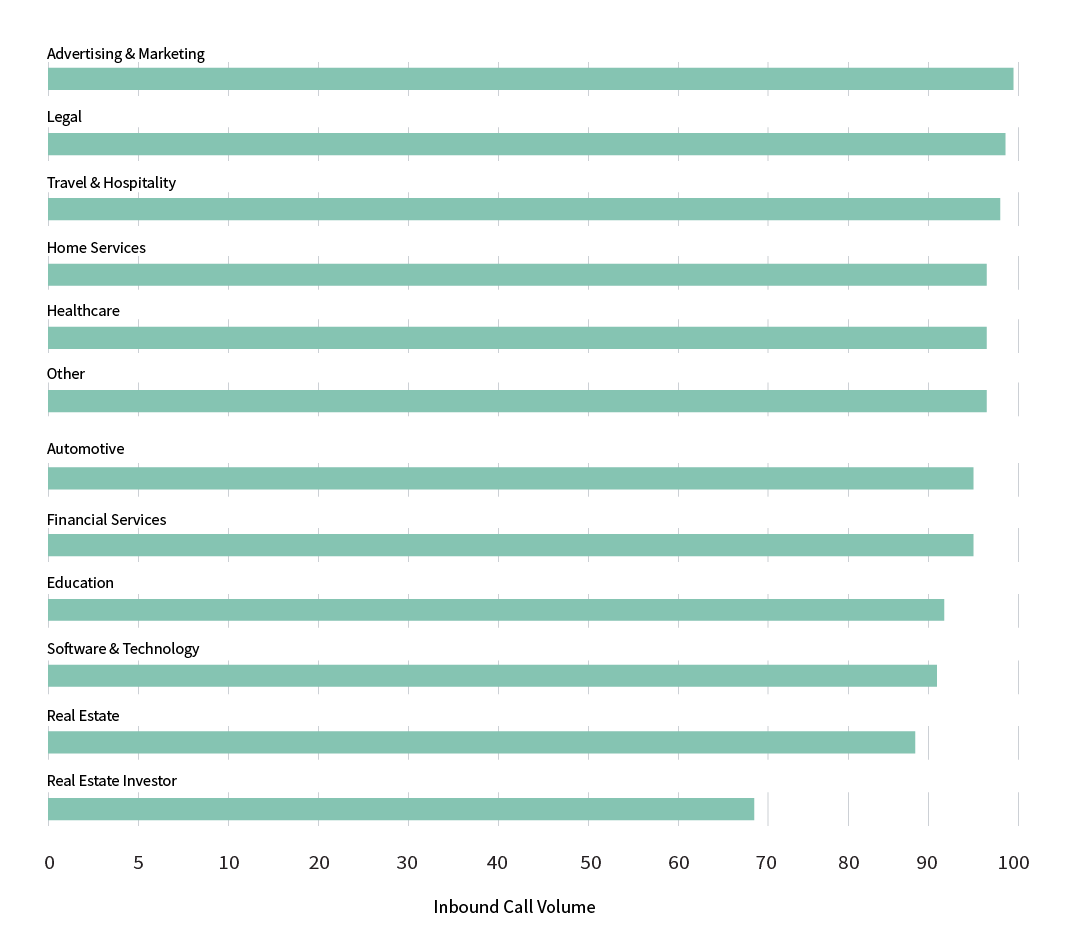What can 129 million calls tell us about inbound marketing? A lot, it turns out.
Leading provider Callrail analyzed more than 129 million calls across 12 industries to understand inbound marketing’s impact on generating calls from leads.
The marketing landscape has shifted since HubSpot introduced the concept of inbound marketing in 2005. Instead of relying on interruptive tactics like cold calling and commercials, inbound marketing focuses on drawing customers to your business through content and channels such as blogs, social media, and video.
Plenty of factors continue driving the shift to inbound marketing, but two stand out from our perspective. The first is customer preference. Millennials, on pace to outnumber baby boomers by 2030, prefer to self-educate when reaching buying decisions. They often do so on their mobile devices, turning to search engines and reaching out to friends on social media.
Those habits, combined with their demand for personalized experiences, means millennials aren’t afraid to hide their annoyance at outbound marketing tactics when online. In fact, 84% report “leaving a favorite website because of intrusive or irrelevant advertising.”
The second reason lies in the value of inbound marketing. According to Kapost, “Inbound Marketing yields three times more leads per dollar than traditional methods.”
But how strongly has the shift toward inbound marketing been? Which industries have experienced the highest volume of inbound calls to date? And how effective is inbound marketing at driving leads to call?
To put some data around these questions, we studied 129,393,520 calls made over 10 months in 2020 (January 6 to October 8). We tracked the percentage of calls that came from inbound marketing methods for each industry. The figure “call volume” refers to calls with leads that were tracked through CallRail’s platform. These calls came from CallRail’s customer base of 150,000 small businesses and agencies. This sample represents 12 industries ranging from healthcare and real estate to home services and legal.

The results, soon to be published on the CallRail blog, show inbound marketing has become a strategy small businesses must invest in — but you probably already knew that. What’s more compelling is how the results show that call-tracking software is one of the best tools available for measuring attribution and optimizing the effectiveness of your inbound marketing and phone calls.
The Importance of Call Tracking for Inbound Marketing
Call-tracking software adds unique phone numbers to your marketing campaigns that lets you 1) see caller data and 2) attribute calls by source and channel to understand campaign effectiveness. Here’s a deeper look at how call tracking impacts your inbound marketing.
A homeowner decides it’s time to fix their leaky faucet. They do a Google search, then click on a plumber’s landing page. From there, they visit the plumber’s Facebook page and watch a few videos. After that, they read reviews about other customers’ experiences with that plumber.
The customer may call at any point through this self-education process. When they do, you, as the business owner, want to know what source prompted them to call. That’s where call tracking comes in.
Through tools such as dynamic number insertion (DNI), call tracking generates and displays unique phone numbers to your potential customers, which forward to your main business line. That builds data on what inbound marketing channels drive your calls, arming you with information to fine-tune your marketing strategies to drive better results.
Industries that stand to benefit most from call tracking
In 11 out of 12 industries we studied, the data shows that more than 91% of leads came from inbound calls. Companies that handle such call volumes have a wealth of data to work with. Call-tracking software can help them use that data to find what inbound marketing channels effectively attract, convert, and close new customers.
Based on our review of 129 million calls, we found that these industries would especially benefit from investing in call tracking. Read on to find out why.
Advertising and Marketing Agencies
Advertising and marketing generated the most calls among the industries we studied with 45 million (29 million more than healthcare, which generated the second-most calls). That volume includes inbound calls made to the agencies, plus inbound calls agencies handled for their clients.
This presents a big opportunity for advertising and marketing agencies to become even more valuable as strategic partners. Clients, especially small businesses with limited time and budget, rely on agencies to show them the most cutting-edge and cost-effective marketing tactics. By using call tracking to attribute and optimize their own marketing, agencies can enhance their existing services and offer new ones.
For instance, agencies can use call tracking to deliver more accurate pay-per-click (PPC) data or even run call tracking on behalf of clients. As our 2021 Digital Marketing Agency Outlook Report shows, the agencies who did best in 2020 were those who reevaluated and expanded what services they could offer, including call tracking.
Industries with Long Sales Cycles
The more complexity involved in buying a product or service, the more inbound marketing efforts such as blog posts, explainer videos, and even chatbots aren’t enough to address all of a customer’s concerns. In those cases, it’s important companies in these industries use call tracking to continually gather data on their leads:
- Software and technology: 91% inbound call volume
- Education: 92% inbound call volume
- Financial services: 94% inbound call volume
- Automotive dealerships: 94% inbound call volume
Call tracking shows you who’s calling, lets you route calls to specific people at your company and compiles an archive of all conversations with each customer. So, no matter if a lead came from an inbound or outbound call, you have the context in front of you to continue developing the relationship and help the customer reach a buying decision.
As the above graphic from Gartner shows, complex sales cycles mean businesses have to be ready for multiple conversations with multiple people over a long period of time. Think about the complexity of buying servers, which would likely mean exploring a range of solutions (data tiers, backup service, security configuration) and having conversations with multiple stakeholders.
With a call tracking tool like CallRail, you capture each of those conversations. Now you have a record that helps you anticipate customers’ needs and guide their journey to a solution.
Call Tracking Software Improves Marketing ROI Across the Board
By giving you visibility into which online and offline marketing efforts drive your calls, call tracking helps you incrementally drive improvements across all of your campaigns. You can attribute calls to sources such as your customers’ Google searches to direct mail pieces, giving you an at-a-glance view of what channels to invest more in — and which to pull back on.
You can drive even deeper insights, too, by adding tools such as Conversation Intelligence. With it, you can do things like automatically qualify calls and track lead values by channel.
original source – https://searchengineland.com/what-can-129-million-calls-tell-us-about-inbound-marketing-a-lot-it-turns-out-344925



